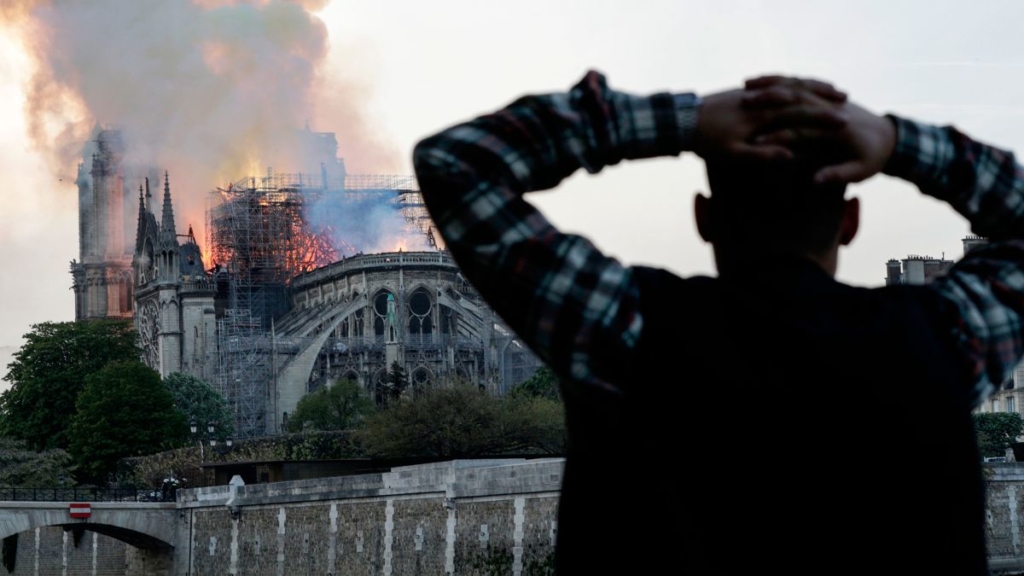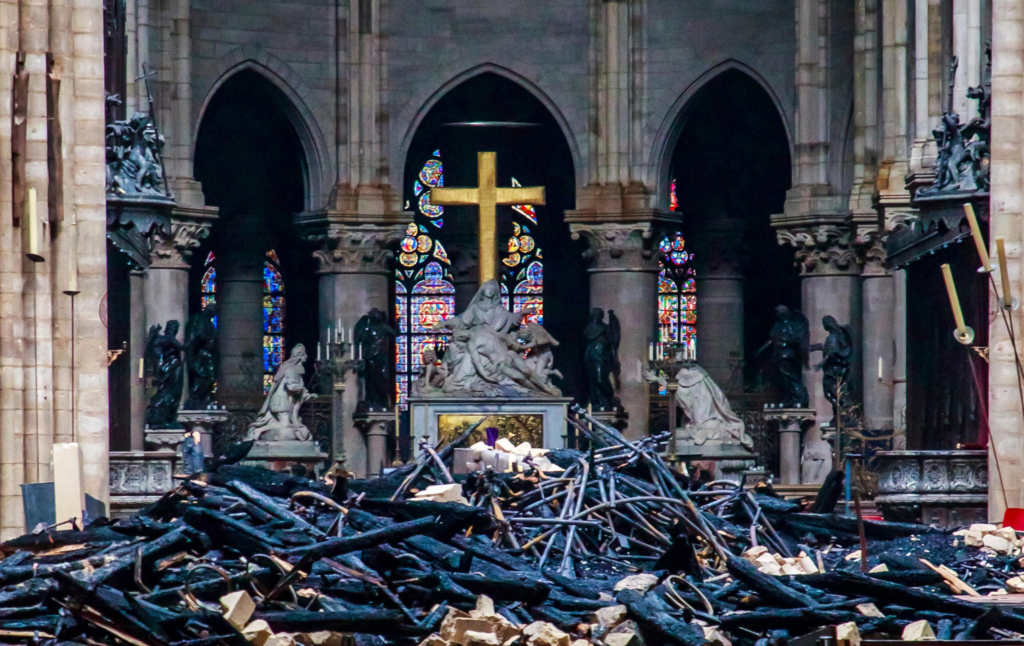Our Lady On Fire
 Our Lady On Fire
Our Lady On Fire
Brian Zahnd
On the one year anniversary I thought I would repost this piece.
It was Monday of Holy Week 2019 and I had just finished leading a noontime prayer service when I heard the awful news that Notre Dame was on fire. Our Lady was on fire! I turned on the television and watched in horror for the next three hours. I hadn’t felt like this since 9/11. I wept. Millions of us did. The French news magazine Paris Match said, “Today, they weep for her in every language.” Ken Follett, author of Pillars of the Earth and an expert on Gothic cathedrals, wrote this:
“The voice on the phone was urgent. ‘I’m in Paris,’ it said. ‘Turn on your television!’ You know what we saw on the screen: the wonderful cathedral of Notre Dame de Paris, one of the greatest achievements of European civilization, was on fire. The scene dazed and disturbed us profoundly. I was on the verge of tears. Something priceless was dying in front of our eyes. The feeling was bewildering, as if the earth was shaking.”
Like millions of others I watched in real time what seemed to be the agonizing death of a priceless treasure. For me, the most dreadful moment came when the 750-ton spire, already engulfed in flames, finally collapsed. It marked the moment when we all feared Notre Dame would be forever lost. Notre Dame had always seemed eternal, and the medieval builders certainly thought it would last until the Day of Judgment; but suddenly we saw that it could be destroyed. Now that everything was on fire how could Our Lady be saved?
I love Paris. I think the “City of Lights” is the most beautiful city in the world. But when you are there you have a palpable sense of its deep secularity. Yes, the medieval cathedrals are still present, but contemporary faith seems pushed to the extreme periphery. Paris is arguably the epicenter of modern atheism and Western secularism. It’s the home of the Enlightenment, the French Revolution, Voltaire, Baron d’Holbach, and Jean-Paul Sartre.
Modern Parisians walking with shoulder-shrugging indifference past Notre Dame day after day could be an apt metaphor for the state of Christianity in a secular age. But as night fell on April 15, 2019, the people of Paris gathered in front of the still burning cathedral and held a candlelight vigil for Our Lady. There was no cheering; no one gloated; no one shouted, “good-riddance;” no one tweeted, “empty the pews and burn it all down.” Instead, television cameras showed thousands of grief-stricken faces lit by the flames, some singing hymns, others just weeping as they watched their beloved cathedral burn.
I suspect many Parisians didn’t know how beloved their cathedral was until they saw it in flames. It would be easy to take Notre Dame for granted, even to ignore her, and yet still assume she would always be there if you ever decided you wanted to visit her. Buildings burn every day, but most of them don’t cause the world to weep. A factory on fire is not the same as a cathedral on fire; Walmart in flames is not the same as Notre Dame in flames. In a secular age suspicious of the sacred, we still know deep down that some things really are sacred. But sometimes we don’t know how sacred they are until they’re on fire. Like Joni Mitchell sang,
Don’t it always seem to go
That you don’t know what you’ve got
‘Till it’s gone
They paved paradise
And put up a parking lot
If I suspect that many Parisians didn’t know how beloved their cathedral was until they saw it in flames, I also suspect that many who think they are done with Christianity may not be as done as they suppose — at least not when they see Our Lady on fire. Most people have a deep-seated instinct that we really don’t want to live in a world devoid of a community that is at least trying to preserve the beauty of Jesus.
We may critique the church; some may be done with the church; others in their anger may shout, “empty the pews!” But do we really think the world would be a better place without the story of Jesus? Do we really want to rid the world of the Beatitudes, the Sermon on the Mount, and the Parable of the Prodigal Son? Do we really think that the world would be better off without Christmas and Easter? Do we honestly think that our own lives will be better if we let our Christian faith burn to the ground? This is not the kind of deconstruction that leads to a better world or a better life. Paris is not better without Notre Dame, and the world is not better without Christianity.
Thankfully, our worst fears were not realized. Notre Dame was not entirely lost. Our Lady did not perish in those awful flames on Holy Monday, but it came close. The New York Times reported that the cathedral came within twenty minutes of being lost. Notre Dame was saved only because a team of firefighters volunteered to carry firehoses up the spiral staircases of the burning bell towers after another team had refused because of the danger. Through the heroic actions of firefighters who risked their lives for the beloved cathedral the towers did not collapse and Notre Dame was saved. It was severely damaged, but not forever lost.
One of the most iconic photos of the Notre Dame fire was taken from inside the cathedral the morning after the blaze. In the foreground we see charred beams from the collapsed roof lying between the pew benches and the altar. On the high altar we see a marble statue of the Virgin Mary holding the lifeless body of Christ after his crucifixion. Above the marble statue is a large golden cross reflecting the light, seeming to stand triumphant above the wreckage. Behind the cross the stained-glass windows at the east end of the cathedral are aglow with the light of sunrise. The photograph bears testimony to the reality of the catastrophe, but on the whole, it brims with hope. In the night everything was on fire, but in the dawn Our Lady still stands, the cross still shines, and rays of hope still illuminate a sacred place.
What can we do when everything is on fire? Perhaps we can recognize that not all structures of belief are the same. Some deserve to be condemned, some need to be deconstructed, some are not worth saving. But other structures of belief are worth risking everything in order to try to save them. I know people who have come to believe in Christ just by visiting Notre Dame. A cathedral that can do something like that is worth saving, and the world is grateful to those firefighters who risked their lives to do so. If a cathedral inspired by and built to the glory of Christian faith is worth saving, how much more is the faith itself worth saving?
If you’re going through a time of deconstruction, maybe it’s worth trying to save that which is precious before you let it all burn down. Maybe it’s worth trying to separate the wheat from the chaff before you launch into a world without any Easters. Deconstruction doesn’t have to mean demolition. I’m convinced that the beautiful cathedral of Christian faith that has stood for two millennia and has helped flood the world with the message of Jesus is worth trying to save. Renovate what needs to be renovated, throw out what needs to be thrown out, deconstruct what needs to be deconstructed, but don’t burn it all down. The cathedral of Christian faith, Our Lady who has nurtured and carried the gospel message of Jesus Christ, is worth our best efforts to save.
BZ
